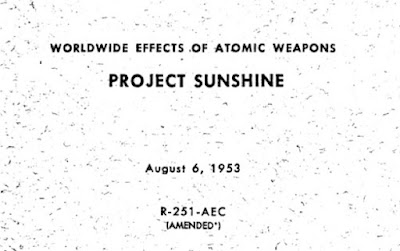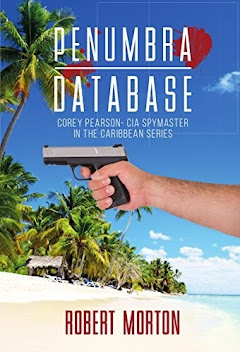 |
| When Conspirarcy Becomes Reality: The Disturbing Truth of Project Sunshine |
We've all had a good laugh at conspiracy
theories, right? You know, those crazy tales whispered in obscure corners of
the internet—the kind that seem way too bizarre to actually be real. But every
once in a while, life decides to mess with us, and one of those far-fetched
stories turns out to be chillingly true. Take "Project Sunshine," for
example. Sounds innocent enough, maybe even cheerful, but beneath the name
lurked a conspiracy theory so disturbing, so weird, that it hardly seemed
credible at first. But as history loves to remind us, reality sometimes has a
very twisted sense of humor.
Back in the early Cold War days, Americans
were still reeling from the terrifying spectacle they'd just witnessed—the
atomic bombs dropped on Hiroshima and Nagasaki. Nobody fully grasped what
radiation really did to the human body or how bad it could get over time.
People were understandably freaked out, wondering what sort of invisible
threats they might face. How dangerous was nuclear fallout, really? Could it
alter human health forever? As panic grew and the questions multiplied, the
U.S. government felt an urgent need to find answers—and fast.
That's when "Project Sunshine"
quietly slipped onto the scene in 1953, courtesy of the Atomic Energy
Commission. At first glance, the idea behind the operation seemed harmless,
even logical: gather human tissue samples from around the globe to study how
radioactive isotopes affected human cells. They especially needed tissue
samples from young bodies, since rapidly developing cells reacted more
dramatically to radiation. Simple enough, right? Unfortunately, what started
out sounding like a straightforward scientific project quickly spiraled into
something much darker and deeply unsettling.
At first, whispers of a sinister plot
emerged among the conspiracy-minded—a shadowy network of government agents
secretly snatching human bodies, particularly the remains of deceased infants
and children. Of course, most people laughed it off as nonsense. After all,
could the government really be stealing bodies secretly? It sounded like
something straight out of a horror movie. Yet, as unbelievable as it was, the
truth turned out even darker than conspiracy theorists ever dreamed.
Declassified files and congressional
inquiries later revealed a disturbing reality: the U.S. government had indeed
orchestrated an international program to gather human tissue covertly. Through
a clandestine global network, agents collected tissue samples, bones, and even
entire limbs from recently deceased babies and young children. Without
permission, without notice, without compassion—more than 1,500 grieving
families unknowingly became part of this macabre effort, their loved ones’
remains harvested quietly and methodically.
The level of secrecy surrounding Project
Sunshine was flat-out mind-boggling. We're talking about an operation buried so
deeply beneath layer after layer of bureaucracy, confidentiality clauses, and
national security excuses that even government officials who weren't directly
involved barely knew it existed. Honestly, it was secrecy cranked up to
eleven—kind of like something straight out of the pages of my Corey Pearson—CIA Spymaster Short
Story series. In those stories, CIA operative Corey Pearson and his
elite CIA team move through missions completely under the radar, handling
delicate assignments in total secrecy, hidden entirely from the public eye. But
here's the thing: while fictional spies like Corey Pearson and his crew operate
secretly to protect national security, Project Sunshine pushed secrecy way
beyond ethical boundaries.
When the unsettling truth finally came to
light, people were genuinely shaken. It wasn’t just the grim details themselves
that disturbed the public—it was the profound betrayal they felt. They had
trusted the government to protect them, inform them, and respect basic human
dignity. Instead, they'd been kept completely in the dark about something
deeply troubling unfolding right beneath their noses.
One particularly haunting example came
from Britain, involving a mother named Jean Prichard. In 1957, Jean endured the
tragic loss of her baby daughter shortly after birth. Decades later, when
declassified documents and investigative reports began to surface in the
mid-1990s, Jean discovered something truly horrifying. Without her knowledge or
consent, British hospital authorities had secretly removed her stillborn
daughter's legs and sent them to U.S. researchers working under Project
Sunshine. Jean lived for decades without even a hint of what had happened,
uncovering this devastating truth only long after the event took place.
Jean's experience wasn't an isolated
incident—it was merely one chilling glimpse into a far-reaching and
disturbingly secretive global operation. It forced people everywhere to ask:
How could something this morally troubling slip unnoticed for so many years?
And perhaps even more unsettling, what other dark secrets are still out there,
quietly hidden away in classified files and forgotten archives?
After revelations like these surfaced,
people didn't just demand answers—they demanded action. Folks were furious,
genuinely shaken, and that anger ignited sweeping changes. Congress was
pressured into action, forcing the government to overhaul its rules about
consent, transparency, and basic human dignity. Yet even now, decades after
Project Sunshine's secrets first crawled out from the shadows, the echoes
remain disturbingly loud.
Because here's the chilling truth: Project
Sunshine wasn't some isolated moment in history—it was a vivid glimpse into how
far unchecked power can really go. It makes you wonder: what other unsettling
secrets are still out there, quietly hidden in dusty government vaults and
locked away in classified files? Could it happen again—this time closer to
home, affecting your family, your friends, even you?
Maybe it's time we paid closer attention.
Maybe it's time we asked tougher questions. Because if there's one thing
history keeps proving, it's this: reality can get darker, stranger, and
infinitely scarier than any conspiracy theory you've ever laughed off.
Robert Morton is a member of the Association of Former Intelligence Officers (AFIO) and an accomplished author. He writes the Corey Pearson- CIA Spymaster Short Story, blending his knowledge of real-life intelligence operations with gripping fictional storytelling. His work offers readers an insider’s glimpse into the world of espionage, inspired by the complexities and high-stakes realities of the intelligence community.





No comments:
Post a Comment